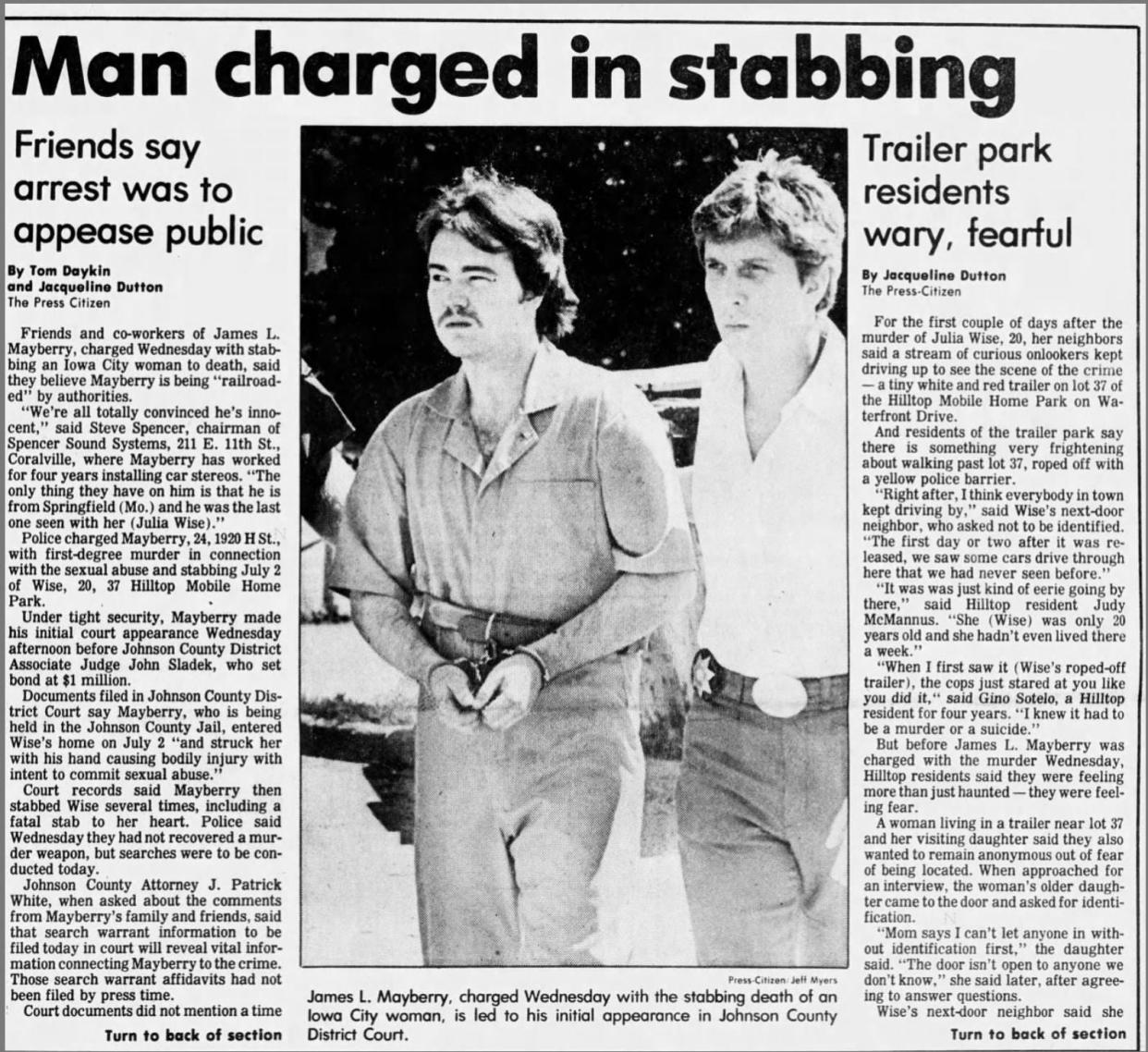Wrongful conviction attorneys say insects prove man innocent in 1985 Iowa City murder

Nearly four decades after he was convicted of murder, James Mayberry is resting his hopes on insects to prove he didn't commit the crime.
Mayberry, 63, has served more than 38 years in prison for the 1985 murder of Julia Wise. The 20-year-old was found stabbed to death in her mobile home just seven days after moving to Iowa City, and Mayberry, the last person who reported seeing her alive, was charged and convicted of her slaying.
He's mounted several unsuccessful appeals and filings for postconviction relief in the decades since. In his latest, filed June 7 in Johnson County court, he's represented by the Iowa Public Defender's Wrongful Conviction Unit. Key to his argument is a scientific field that didn't exist at the time of his trial: forensic entomology, the study of how insects infest and feed on corpses.
Elaina Steenson, an attorney with the wrongful conviction unit, said her office has been working with Mayberry for several years, starting with DNA testing that excluded him as the source of several hairs found on the victim's clothing.
"We thoroughly believe in Mr. Mayberry's innocence, and thus began our investigation for Mr. Mayberry's current pending" postconviction relief application, she told the Register.
The Johnson County Attorney's Office did not respond to a message seeking comment.
What happened to Julia Wise?
Originally from Missouri, Wise moved to Iowa City on June 28, 1985, intending to attend school and work at a store in Cedar Rapids, according to court filings. She bought a home in the Hilltop Trailer Court.
On July 4, after her parents were unable to reach her, the trailer park manager checked her trailer and found Wise dead. Her shorts and underwear had been cut away and she'd been stabbed several times in the chest and abdomen.
Wise's parents told police she had a history of "risky behavior," including picking men up from bars, and had had several abusive ex-boyfriends. But investigators soon focused their investigation on Mayberry, the brother-in-law of Wise's next-door neighbor.
Why was Mayberry convicted?
Mayberry told police he'd met Wise while visiting the park July 2, and that she'd given him a cup of water. He also tried to help install a TV antenna, using a knife from her kitchen. He told police he'd gone home prior to 10:30 that evening, making him the last known person known to have seen Wise alive.
Investigators found Mayberry's fingerprints in Wise's home on a water glass, a steak knife and her eyeglasses, all items he mentioned having touched. A medical examiner estimated Wise had been dead for 24 to 48 hours before being discovered, although he later testified it was a "crude guess." During interviews, police reportedly accused Mayberry of having an affair with Wise ,leading to her death.
How can bugs help solve a murder?
Mayberry's visit to Wise's trailer fits the original medical examiner's estimated time of death. But in his latest filing, Mayberry's attorneys argue new evidence shows that estimate was wrong.
Forensic entomology uses known factors, such as the weather and time of year, to calculate how quickly blow flies and other insects are drawn to decomposing bodies. Blow flies are known to lay their eggs in corpses, and investigators can use the number and life stage of the resulting offspring to estimate how long a body has been in place.
Mayberry's attorneys point out in his filing that neither witnesses who found the body nor the subsequent autopsy found any signs of insect activity. The filing notes that July 3 and 4, 1985, were hot days, peaking above 90 degrees, and it was even warmer in the poorly-sealed trailer with open windows where Wise's body was found.
If in fact Wise had been laying there for nearly two days, as prosecutors believed, scientists would expect to see blowfly eggs and larva on her remains, Mayberry's attorneys argue. The lack of such evidence suggests she'd been killed no more than 12 to 16 hours before she was found, long after Mayberry's visit.
Defendants face a high bar, including a statute of limitations, in court actions for postconviction relief. Steenson, though, noted the law includes an exception for cases in which there is newly discovered evidence that could not have been discovered at the time.
"We are excited to begin litigation on Mr. Mayberry's case, and are hopeful that he will have his day in court to prove his innocence," she said.
Entomology used in past Iowa murder cases
Mayberry's case wouldn't be the first in Iowa to use entomological evidence.
In one 2017 case from Chickasaw County, prosecutors charged a father with murder and child endangerment after his son was found dehydrated, starving and wearing a filthy, maggot-infested diaper. An expert testified the child would have had to been wearing the unchanged diaper for 10 to 14 days for the insect infestation to have reached that level.
More recently, James Klever was convicted in 2023 of killing a Des Moines woman and keeping her body in his trunk for almost a week before dumping her remains in a Missouri river. The jury heard evidence that blowflies infesting the lining of Klever's car were found to have consumed human blood.
Steenson said she isn't aware of any Iowans who've been exonerated based on entomology, but it has happened in other states. Kirstin Lobato was convicted in 2006 of a 2001 murder in Nevada, but her conviction was overturned in 2017 after entomologists testified that based on a lack of flies on the victim, he would have died at a time when Lobato was three hours away.
William Morris covers courts for the Des Moines Register. He can be contacted at wrmorris2@registermedia.com or 715-573-8166.
This article originally appeared on Des Moines Register: 1985 Iowa City murder conviction challenged with forensic entomology
